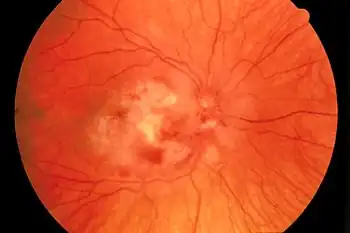Retinitis
| Retinitis | |
|---|---|
 | |
| Retinitis caused by CMV (fundus photograph) | |
Retinitis is inflammation of the retina in the eye, which can permanently damage the retina and lead to blindness. The retina is the eye's "sensing" tissue. Retinitis may be caused by a number of different infectious agents. Its most common form, called retinitis pigmentosa, has a prevalence of one in every 2,500–7,000 people. This condition is one of the leading causes that leads to blindness in patients in the age range of 20–60 years old.
Retinitis may be caused by several infectious agents, including toxoplasmosis,[1] cytomegalovirus and candida.[2] Cytomegalovirus retinitis is an important cause of blindness in AIDS patients.[2] Candida spreading to the retina from the bloodstream usually results in the production of several retinal abscesses.[2]
Symptoms and signs
First symptom of this disease is usually a slow loss of vision, especially that of night vision, making it harder to drive in the dark. Later signs include loss of peripheral vision, leading to tunnel vision. In some cases, symptoms are experienced in only one of the eyes. Experiencing floaters, flashes, blurred vision and loss of side vision in just one eye may be an early indication of onset of retinitis.
Mechanism
Retinitis is a genotypic disease which entails severe phenotypic representation. Types of it are currently considered the most complex forms of retinal disease. Such complexity in disease and incurability results from its complex mechanism. Retinitis is controlled by a single gene which can be inherited via an autosomal dominant, autosomal recessive, or X-linked gene. In many cases, individuals with retinitis have parents or other relatives unaffected by the disease.
Diagnosis

Although there has been extensive research in the past decades on the disease, there is still no evidence-based therapies for this condition which is often diagnosed at an early age, usually in teenagers or young adults.
To make a specific diagnosis, intraocular fluid samples may be taken and sent for analysis. In some cases, blood or cerebrospinal fluid (CSF) are also tested. Imaging may be done to help make the diagnosis.
Types
There are two types of the disease: retinitis pigmentosa (RP) and cytomegalovirus (CMV) retinitis. Both conditions result in the swelling and damage to the retina. However, the key difference is that RP is a genetic problem inherited from one or both of parents. On the other hand, CMVR develops from a viral infection in the retina. While there is no cure for the disease, there are steps you can take to protect your vision from worsening.
Prevention
Research indicates that some supplements, especially vitamin A, lutein, and omega-3 fatty acids, may slow down the progression of the disease and alleviate symptoms temporarily.
Treatment
It is extremely important to see an ophthalmologist regularly. While supplements mentioned above may help reduce the symptoms, retinitis itself is not curable. Additionally, devices such as low-vision magnifiers can be used to aid vision in patients with despaired vision due to retinitis. Rehabilitation services may also aid the patient so that patients may use their vision in a more effective way. Lastly, it is advisable to wear sunglasses even on gloomy days to protect the eyes from UV radiation.
Recent research
Current research on retinitis includes studying stem cells, medications, gene therapies, and transplants to help treat/cure this condition. One study including patients with retinitis was conducted by using gene therapy.
References
- ↑ Goldman, Lee (2011). Goldman-Cecil Medicine (24th ed.). Philadelphia: Elsevier Saunders. p. 2195. ISBN 978-1437727883.
- 1 2 3 Kumar, Vinay (2007). "Retina and Vitreous, Other Retinal Degenerations, Retinitis". Robbins basic pathology (8th ed.). Philadelphia: Saunders/Elsevier. ISBN 978-1416029731.
- Retinitis. (n.d.). Retrieved December 12, 2017, from https://www.webmd.com/eye-health/retinitis-types-symptoms-treatment#1 Archived 2022-05-16 at the Wayback Machine
- Parmeggiani, F. (2011). Clinics, Epidemiology and Genetics of Retinitis Pigmentosa. Current Genomics, 12(4), 236–237. http://doi.org/10.2174/138920211795860080 Archived 2022-09-27 at the Wayback Machine
External links
| Classification |
|---|